59 (2007), 23–30 LC A. Kanibir and P. Girginok
advertisement
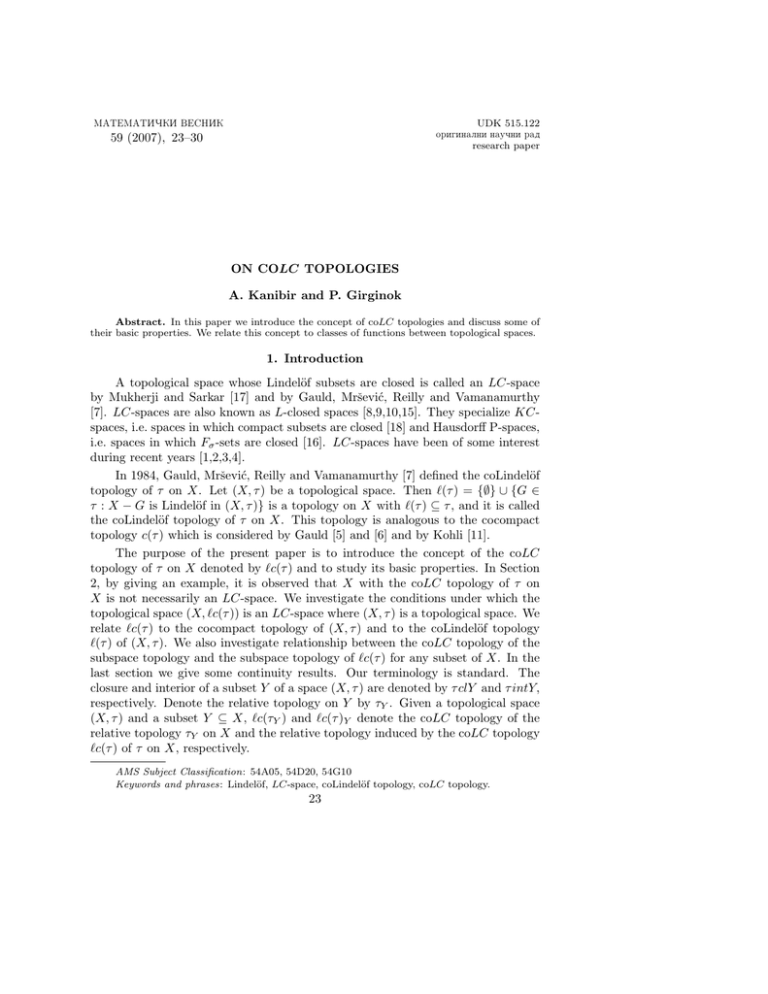
MATEMATIQKI VESNIK
UDK 515.122
originalni nauqni rad
research paper
59 (2007), 23–30
ON COLC TOPOLOGIES
A. Kanibir and P. Girginok
Abstract. In this paper we introduce the concept of coLC topologies and discuss some of
their basic properties. We relate this concept to classes of functions between topological spaces.
1. Introduction
A topological space whose Lindelöf subsets are closed is called an LC-space
by Mukherji and Sarkar [17] and by Gauld, Mršević, Reilly and Vamanamurthy
[7]. LC-spaces are also known as L-closed spaces [8,9,10,15]. They specialize KCspaces, i.e. spaces in which compact subsets are closed [18] and Hausdorff P-spaces,
i.e. spaces in which Fσ -sets are closed [16]. LC-spaces have been of some interest
during recent years [1,2,3,4].
In 1984, Gauld, Mršević, Reilly and Vamanamurthy [7] defined the coLindelöf
topology of τ on X. Let (X, τ ) be a topological space. Then `(τ ) = {∅} ∪ {G ∈
τ : X − G is Lindelöf in (X, τ )} is a topology on X with `(τ ) ⊆ τ , and it is called
the coLindelöf topology of τ on X. This topology is analogous to the cocompact
topology c(τ ) which is considered by Gauld [5] and [6] and by Kohli [11].
The purpose of the present paper is to introduce the concept of the coLC
topology of τ on X denoted by `c(τ ) and to study its basic properties. In Section
2, by giving an example, it is observed that X with the coLC topology of τ on
X is not necessarily an LC-space. We investigate the conditions under which the
topological space (X, `c(τ )) is an LC-space where (X, τ ) is a topological space. We
relate `c(τ ) to the cocompact topology of (X, τ ) and to the coLindelöf topology
`(τ ) of (X, τ ). We also investigate relationship between the coLC topology of the
subspace topology and the subspace topology of `c(τ ) for any subset of X. In the
last section we give some continuity results. Our terminology is standard. The
closure and interior of a subset Y of a space (X, τ ) are denoted by τ clY and τ intY,
respectively. Denote the relative topology on Y by τY . Given a topological space
(X, τ ) and a subset Y ⊆ X, `c(τY ) and `c(τ )Y denote the coLC topology of the
relative topology τY on X and the relative topology induced by the coLC topology
`c(τ ) of τ on X, respectively.
AMS Subject Classification: 54A05, 54D20, 54G10
Keywords and phrases: Lindelöf, LC-space, coLindelöf topology, coLC topology.
23
24
A. Kanibir and P. Girginok
2. CoLC topologies
Firstly we give the following results which will be needed in the sequel.
Proposition 1. The union of any two closed LC-subspaces of (X, τ ) is an
LC-subspace.
Proof. Let K1 , K2 ⊆ X be closed, LC-subspaces of (X, τ ). Let K be a Lindelöf
subset of (K1 ∪ K2 , τK1 ∪K2 ). Then K ∩ K1 is a Lindelöf subset of (K1 , τK1 ). Since
K1 is an LC-subspace of (X, τ ), K ∩ K1 is closed in (K1 , τK1 ). The set K ∩ K1
is closed in X since K1 is closed in (X, τ ). Similarly K ∩ K2 is closed in (X, τ ).
Thus (K ∩ K1 ) ∪ (K ∩ K2 ) = K is closed in (X, τ ). This implies that K is closed
in (K1 ∪ K2 , τK1 ∪K2 ). Hence K1 ∪ K2 is an LC-subspace of (X, τ ).
Corollary 2. Let X be a topological space. If X can be expressed as the
union of two closed LC-subspaces, then X is an LC-space.
Definition 3. Let (X, τ ) be a topological space. The collection `c(τ ) =
{∅} ∪ {U ∈ τ : X − U is an LC-subspace in (X, τ )} is a topology on X with
`c(τ ) ⊆ τ, called the coLC topology of τ on X.
It is easy to see that `c(τ ) is a topology on X since the LC property is hereditary [17] and by Proposition 1.
The next example shows that (X, `c(τ )) is not necessarily an LC-space, even
if (X, τ ) is Lindelöf.
Example 4. Let X be an uncountable set and τ be the countable complement
topology on X. The coLC topology of τ on X is τ, that is τ = `c(τ ). Since (X, τ )
is not an LC-space [17], (X, `c(τ )) is not an LC-space.
Proposition 5. If (X, τ ) is an LC-space, then τ = `c(τ ).
Proof. By definition `c(τ ) ⊆ τ . Now take U ∈ τ . Then X − U is an LCsubspace of (X, τ ) since X is an LC-space and the LC property is hereditary.
Hence U ∈ `c(τ ).
Example 4 shows that the reverse implication of Proposition 5 does not hold
in general.
Proposition 6. Let (X, τ ) be a topological space. If τ = `c(τ ) and (X, τ ) has
no Lindelöf-dense subset, then (X, τ ) is an LC-space.
Proof. Let L be a Lindelöf subset of (X, τ ). Then L is Lindelöf in the subspace
τ clL of (X, τ ). Now X − τ clL 6= ∅ by hypothesis. Since X − τ clL ∈ τ = `c(τ )
we have that X − (X − τ clL) = τ clL is an LC-subspace of (X, τ ) and hence L is
closed in τ clL. Since τ clL is closed in (X, τ ), L is closed in (X, τ ). Hence (X, τ ) is
an LC-space.
In the above theorem the condition that (X, τ ) has no Lindelöf-dense subset
can not be removed as the Example 4 shows.
On coLC topologies
25
Corollary 7. Let (X, τ ) be a topological space. If (X, `c(τ )) has no Lindelöfdense subset then (X, `c(τ )) is an LC-space.
Proof. Firstly we show that (X, τ ) is an LC-space. Let L be a Lindelöf subset of
(X, τ ). Then L is Lindelöf in the subspace τ clL of (X, τ ). We have τ clL ⊆ `c(τ )clL
and `c(τ )clL 6= X by hypothesis. Since X − `c(τ )clL ∈ `c(τ ), `c(τ )clL is an LCsubspace of (X, τ ). Then τ clL is an LC-subspace of (X, τ ). Hence L is closed
in τ clL. Since τ clL is closed in (X, τ ), L is closed in (X, τ ). Thus (X, τ ) is an
LC-space. We obtain τ = `c(τ ) from Proposition 5 and hence (X, `c(τ )) is an
LC-space.
Theorem 8. For a space (X, τ ) the following are equivalent:
(1) (X, τ ) is an LC-space.
(2) (X, `c(τ )) is an LC-space.
Proof. (1)⇒(2) It follows from Proposition 5.
(2)⇒(1) Let L be a Lindelöf subset of (X, τ ). All Lindelöf subsets of (X, τ ) are
Lindelöf in (X, `c(τ )) since `c(τ ) ⊆ τ . Thus L is Lindelöf in (X, `c(τ )) and so L is
closed in (X, `c(τ )) since (X, `c(τ )) is an LC-space. Hence L is closed in (X, τ ).
Remark 9. Let (X, τ ) be a topological space which is not countable discrete.
If (X, `c(τ )) is a separable space, then (X,`c(τ )) and (X, τ ) are not LC-spaces.
Hence if (X, `c(τ )) is second countable, then (X, `c(τ )) and (X, τ ) are not LCspaces.
Proposition 10. If (X, `c(τ )) is Hausdorff, then (X, τ ) is an LC-space.
Proof. Let x, y ∈ X and x 6= y. Since (X, `c(τ )) is Hausdorff, there are
U, V ∈ `c(τ ) such that x ∈ U, y ∈ V and U ∩ V = ∅. Thus X = (X − U ) ∪ (X − V )
and hence X can be written as the union of two closed, LC-subspaces of (X, τ ).
By Corollary 2 (X, τ ) is an LC-space.
Corollary 11. Let (X, τ ) be a topological space. If (X, `c(τ )) is Hausdorff,
then (X, `c(τ )) is an LC-space.
The following example shows that if (X, τ ) is Hausdorff, then (X, τ ) is not
necessarily an LC-space.
Example 12. Let R be the set of real numbers and τ be the usual topology
on R. Then (R, τ ) is Hausdorff. The subset Q of rational numbers is Lindelöf but
not closed. Hence (R, τ ) is not an LC-space.
Proposition 13. Let (X, τ ) be a topological space. (X, `c(τ )) is an LC-space
if it can be expressed as the union of two closed sets which are not equal to X.
Proof. Let X = K1 ∪ K2 and let K1 6= X, K2 6= X be closed in (X, `c(τ )).
Then K1 and K2 are LC-subspaces of (X, τ ) by Definition 3. Therefore (X, τ ) is an
LC-space by Corollary 2, since K1 and K2 are closed in (X, τ ). Hence (X, `c(τ ))
is an LC-space by Theorem 8.
26
A. Kanibir and P. Girginok
Corollary 14. If (X, `c(τ )) is not connected, then (X, `c(τ )) is an LC-space.
Theorem 15. Let (X, τ ) be a topological space. Then (X, τ ) is an LC-space
and not connected if and only if (X, `c(τ )) is not connected.
Proof. (⇒) Let (X, τ ) be an LC-space and non-connected. Then τ = `c(τ ) by
Proposition 5. Hence (X, `c(τ )) is not connected.
(⇐) (X, τ ) is not connected since (X, `c(τ )) is non-connected and `c(τ ) ⊆ τ .
By Corollary 14, (X, `c(τ )) is an LC-space since (X, `c(τ )) is non-connected. Hence
(X, τ ) is an LC-space by Theorem 8.
The following four generalizations of LC-spaces and Theorem are given by
Dontchev, Ganster and Kanibir [2].
Definition 16. A topological space (X, τ ) is called:
(1) an L1 -space if every Lindelöf Fσ -set is closed,
(2) an L2 -space if τ clL is Lindelöf whenever L ⊆ X is Lindelöf,
(3) an L3 -space if every Lindelöf subset L is an Fσ -set,
(4) an L4 -space if, whenever L ⊆ X is Lindelöf, then there is a Lindelöf Fσ -set
F with L ⊆ F ⊆ τ clL.
Theorem 17. (1) If (X, τ ) is an LC-space, then (X, τ ) is an Li -space, i =
1, 2, 3, 4.
(2) Every L2 -space is an L4 -space and every L3 -space is an L4 -space.
Proposition 18. Let (X, τ ) be a topological space. If (X, `c(τ )) has no Lindelöf-dense subset, then (X, τ ) and (X, `c(τ )) are Li -spaces, i = 1, 2, 3, 4.
Proof. (X, `c(τ )) is an LC-space by Corollary 7 since (X, `c(τ )) has no Lindelöf-dense set. Thus (X, τ ) is an LC-space. By Theorem 17(1) (X, τ ) and
(X, `c(τ )) are Li -spaces, i = 1, 2, 3, 4.
Proposition 19. Let (X, τ ) be a topological space. If (X, `c(τ )) is an L2 -space
but not an LC-space, then (X, `c(τ )) is a Lindelöf space.
Proof. Let (X, `c(τ )) be L2 and not an LC-space. Then there is a Lindelöfdense set L in (X, `c(τ )) by Corollary 7 and `c(τ )clL = X. Hence (X, `c(τ )) is a
Lindelöf space since (X, `c(τ )) is an L2 -space.
A space (X, τ ) satisfying the hypothesis of the previous Proposition is given
by Example 4.
Proposition 20. If (X, τ ) is T1 , then (X, `c(τ )) is T1 .
Proof. Let x ∈ X. Since (X, τ ) is T1 and {x} is an LC-subspace of (X, τ ),
X − {x} ∈ `c(τ ). Hence {x} is closed in (X, `c(τ )). Thus (X, `c(τ )) is T1 .
Example 12 shows that if (X, τ ) is Hausdorff then (X, `c(τ )) is not necessarily
Hausdorff. (R, τ ) is Hausdorff, but is not an LC-space. Hence (R, `c(τ )) is not
Hausdorff by Proposition 10.
On coLC topologies
27
Recall that if (X, τ ) is a topological space, then the cocompact topology of τ
on X is c(τ ) = {∅} ∪ {U ∈ τ : X − U is compact in (X, τ )} [5].
Proposition 21. Let (X, τ ) be a topological space.
(1) If (X, τ ) is an LC-space, then `(τ ) ⊆ `c(τ ) and c(τ ) ⊆ `c(τ ).
(2) If (X, τ ) is a Lindelöf space, then `c(τ ) ⊆ `(τ ).
(3) If (X, τ ) is a compact space, then `c(τ ) ⊆ c(τ ).
Proof. (1) Let (X, τ ) be an LC-space. Then τ = `c(τ ) by Proposition 4. Since
`(τ ) ⊆ τ and c(τ ) ⊆ τ , `(τ ) ⊆ `c(τ ) and c(τ ) ⊆ `c(τ ). This completes the proof.
(2) Let (X, τ ) be a Lindelöf space. Then τ = `(τ ) by Corollary 1 of [7]. Since
`c(τ ) ⊆ τ, `c(τ ) ⊆ `(τ ). This completes the proof.
(3) Let (X, τ ) be a compact space. Then c(τ ) = τ by Corollary 3 of [5]. Hence
`c(τ ) ⊆ τ .
Note that the reverse inclusions of (1), (2) and (3) are false in general.
Example 22. Let X be an uncountable set and let τ be the discrete topology
on X. Since X is an LC-space, τ = `c(τ ) by Proposition 5. It is clear that τ 6= `(τ )
and τ 6= c(τ ). Hence `c(τ ) * `(τ ) and `c(τ ) * c(τ ).
Example 23. Let X be the set of real numbers with the usual topology,
Y = {0} ∪ { n1 : n = 1, 2, 3, . . . } and let τ be the topology induced on the set Y by
the topology of X. Since (Y, τ ) is compact, it is Lindelöf. Hence τ = c(τ ) = `(τ ).
We take { 21 } ∈ τ and A = {1, 13 , 14 , . . . }. Then A ⊆ K = Y − { 21 } is a Lindelöf
subset of (K, τK ), but not closed in (K, τK ). Therefore K is not an LC-subspace
of (Y, τ ). So { 21 } ∈
/ `c(τ ). Hence c(τ ) * `c(τ ) and `(τ ) * `c(τ ).
Proposition 24. Let L be a subset of the topological space (X, τ ). Then
`c(τ )L ⊆ `c(τL ).
Proof. Suppose U ∈ `c(τ )L . Then there is a subset A ∈ `c(τ ) with U = A ∩ L.
Since A ∈ `c(τ ), X−A is an LC-subspace of (X, τ ). Thus L−U is an LC-subspace of
(X −A, τX−A ). Hence L−U is an LC-subspace of (X, τ ) since (τX−A )L−U = τL−U .
Further U ∈ τL , so U ∈ `c(τL ). Hence `c(τ )L ⊆ `c(τL ).
Theorem 25. Let (X, τ ) be a topological space and Y ⊆ X. If τ = `c(τ ), then
τY = `c(τY ) = `c(τ )Y .
Proof. Firstly we will show that τY ⊆ `c(τY ). Let UY ∈ τY and UY = U ∩ Y,
U ∈ τ . Since τ = `c(τ ), X − U is an LC-subspace of (X, τ ). Therefore Y − UY is
an LC-subspace of (X, τ ) because of Y − UY ⊆ X − U . Since τY −UY = (τY )Y −UY ,
Y − UY is an LC-subspace of (Y, τY ). Hence τY ⊆ `c(τY ).
We observe that `c(τY ) ⊆ τY . Thus τY = `c(τY ). We have τY = `c(τ )Y from
the hypothesis. Hence τY = `c(τY ) = `c(τ )Y .
Note that, if (X, τ ) is an LC-space, then Proposition 5 and Theorem 25 imply
that τY = `c(τY ) = `c(τ )Y for every Y ⊆ X.
28
A. Kanibir and P. Girginok
Note that the τ = `c(τ ) condition in Theorem 25 can not be removed as the
following example shows. This example also shows that the reverse inclusion of
Proposition 24 is false in general.
Example 26. Let X = {a, b, c, d}, Y = {a, b} and τ = {∅, X, {a}, {b, c, d}}.
Then `c(τ ) = {∅} ∪ {U ∈ τ : X − U is an LC-subspace in (X, τ )} = {∅, X, {b, c, d}}
and τY = {∅, Y, {a}, {b}}. Therefore `c(τ )Y = {∅, Y, {b}} and `c(τY ) = {∅, Y, {a},
{b}}. Hence `c(τY ) 6= `c(τ )Y .
3. Some continuity results
Now we give some definitions. Let P denote a property, not necessarily topological, possessed by certain subsets of a topological space.
Definition 27. [13] Let X be a topological space and A ⊆ X. Then
(1) A is a P -set if A possesses property P ; and
(2) A has P -complement if X − A possesses property P .
Definition 28. Let f : X → Y be a function from a topological space X into
a topological space Y . Then f is said to be
(1) P -continuous [12] if for each x ∈ X and each open set V containing f (x)
and having P -complement, there is an open set U containing x such that f (U ) ⊆ V ;
and
(2) P ∗ -continuous [14] if for each x ∈ X and set B with f (x) ∈ intB, whenever
B has P -complement, there is an open set U containing x such that f (U ) ⊆ B.
The class of P ∗ -continuous functions constitutes a subclass of the class of P continuous functions, and they coincide with each other if the property P implies
the property of being a closed set.
In the above definition if P denotes the property of being a closed LC-subspace,
then we have the following definition.
Definition 29. A function f : X → Y is called `c-continuous if for each point
x ∈ X and each open set V containing f (x) and having LC-complement there is
an open set U containing x such that f (U ) ⊆ V .
It is immediate from these definitions that every continuous function is `ccontinuous. However, the reverse implication does not hold in general.
For example, let X = Y = {a, b, c, d}, ϑ = {Y, ∅, {b, c, d}}, τ = {X, ∅, {a},
{b, c, d}}. Let f be the identity mapping from (X, ϑ) onto (Y, τ ). Then f is `ccontinuous but it is not continuous.
Theorem 30. Let f : X → Y be an `c-continuous function such that f (X) is
contained in a closed LC-subspace of Y . Then f is continuous.
Proof. Let L be a closed LC-subspace of Y containing f (X) and V be any
open subset of Y . Then V ∪ (Y −L) is an open subset of Y having LC-complement.
Now the result follows since f is `c-continuous and f −1 (V ) = f −1 (V ∪ (Y − L)).
On coLC topologies
29
The proof of the following result is straightforward, so we omit it.
Theorem 31. Let f : X → Y be a function from a topological space X into a
topological space Y . The following statements are equivalent.
(1) f is `c-continuous,
(2) for every A of Y having LC-complement, f −1 (intA) ⊆ intf −1 (A).
There are more results that are related to `c-continuous functions that are
similar to section 3 of [14].
The following Theorem is the `c-continuity version of a result given for `continuous functions in [7]. Its proof follows from the definitions.
Theorem 32. The function f : (X, ϑ) → (Y, τ ) is `c-continuous if and only if
f : (X, ϑ) → (Y, `c(τ )) is continuous.
Now we give a stronger version of `c-continuity similar to strong `-continuity
in [7].
Definition 33. A function f : (X, ϑ) → (Y, τ ) is called strongly `c-continuous
if f : (X, `c(ϑ)) → (Y, `c(τ )) is continuous.
It is clear from Theorem 32 that strong `c-continuity implies `c-continuity. On
the other hand, `c-continuity does not imply strong `c-continuity in general.
Example 34. Let X = {a, b, c, d, e}, ϑ = {X, ∅, {a, b, c}, {d, e}}. Let Y =
{a, b, c, d}, τ = {Y, ∅, {a, b, c}, {d}}. Let f : (X, ϑ) → (Y, τ ) be a function defined
by f (a) = a, f (b) = b, f (c) = c, f (d) = d, f (e) = d. Then f is `c-continuous but it
is not strongly `c-continuous.
The following result is immediate from Theorem 32 and Definition 33.
Proposition 35. If f : (X, ϑ) → (Y, τ ) is `c-continuous and g : (Y, τ ) →
(Z, υ) is strongly `c-continuous then g ◦ f is `c-continuous.
Acknowledgement. The authors would like to thank Professor Ivan L.
Reilly for his helpful discussions during preparation of this paper.
REFERENCES
[1] Dontchev, J. and Ganster, M., On the product of LC-spaces, Q&A in General Topology,
15(1) (1997), 71–74.
[2] Dontchev, J., Ganster, M. and Kanibir, A., On some generalizations of LC-spaces, Acta
Math. Univ. Comenianae, 57,2 (1999), 345–353.
[3] Dontchev, J., Ganster, M. and Kanibir, A., On locally LC-spaces, Mem. Fac. Sci. Kochi.
Univ.(Math.) 21 (2000), 73–77.
[4] Ganster, M., Kanibir, A. and Reilly, I.L., Two comments concerning certain topological
spaces, Indian J. Pure Appl. Math., 29(9) (1998), 965–967.
[5] Gauld, D.B., c-continuous functions and cocompact topologies, Kyungpook Math. J., 18
(1978), 151–157.
[6] Gauld, D.B., Topologies related to notions of near continuity, Kyungpook Math. J., 21
(1981), 195–204.
30
A. Kanibir and P. Girginok
[7] Gauld, D.B., Mršević M., Reilly I.L. and Vamanamurthy M.K., CoLindelöf topologies and
`-continuous functions, Glasnik Matematički, 19(39) (1984), 297–308.
[8] Hdeib, H.Z., A note on L-closed spaces, Q&A in General Topology, 6 (1988), 67–72.
[9] Hdeib, H.Z. and Pareek, C.M., On spaces in which Lindelöf sets are closed, Q&A in General
Topology, 4 (1986), 3–13.
[10] Henrikson, M. and Woods, R.G., Weak P -spaces and L-closed spaces, Q&A in General Topolgy, 6 (1988), 201–207.
[11] Kohli, J.K., A class of mappings containing all continuous mappings, Glasnik Matematički,
16(36) (1981), 361–367.
[12] Kohli, J.K., A unified approach to continuous and certain non-continuous functions, Symposium on General Topology and its Applications, Delhi (1978).
[13] Kohli, J.K., A unified view of (complete) regularity and certain variants (complete) regularity, Canad. J. Math., 36 (1984),783–794.
[14] Kohli, J. K., A framework including the theories of continuities and certain non-continuous
functions, Note di Math., 10, 1 (1990), 37–45.
[15] Levy, R., A non-P L-closed space, Q&A in General Topology, 4 (1986),145–146.
[16] Misra, A.K., A topological view of P -spaces, Topology & Appl., 2 (1972), 349–362.
[17] Mukherji, T.K. and Sarkar, M., On a class of almost discrete space, Mat. Vesnik, 3(16)(31)
(1979), 459–474.
[18] Wilansky, A., Between T1 and T2 , Amer. Math. Monthly., 74 (1967), 261–266.
(received 02.02.2006, in revised form 07.06.2007)
Department of Mathematics, Hacettepe University, 06532 Beytepe, Ankara, Turkey
E-mail: kanibir@hacettepe.edu.tr


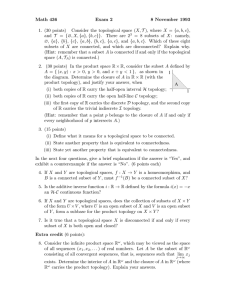
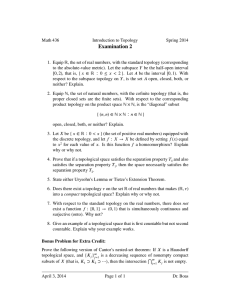
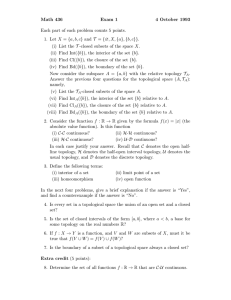
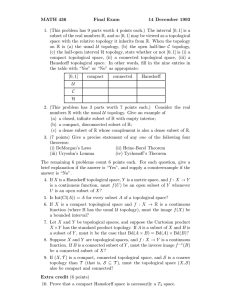

![MA342A (Harmonic Analysis 1) Tutorial sheet 2 [October 22, 2015] Name: Solutions](http://s2.studylib.net/store/data/010415895_1-3c73ea7fb0d03577c3fa0d7592390be4-300x300.png)
